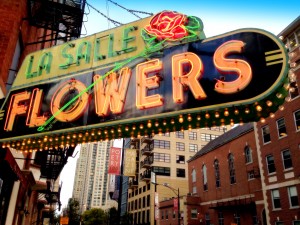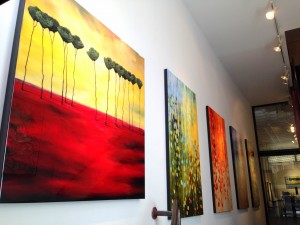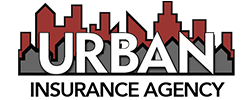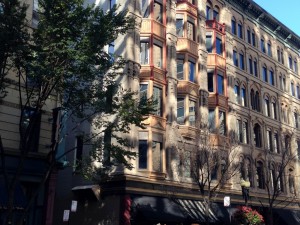Chicago is a city made up of neighborhoods, each with their own history and ever changing demographics. As immigrants made the city home, they tended to congregate for comfort and support, each new wave reshaping the neighborhoods . German shops slowing giving way to Polish restaurants, that in turn find a new identity with each new group entering and enriching Chicago. “River North” has a similar rich ethnic history, but the near-north area also is a tale of gentrification.
The actual boundaries are determined by the Chicago River on the South and West, Division Street on the North and Wabash Avenue on the East. The area at the turn of the 20th century got the name “Smokey Hollow” owing to the massive number of factories and the burning of coal needed to power them. Raw goods could be brought in by ship or rail, and the manufactured products could then be sent out to the world with the river and trains linking the district to Chicago ports. As traffic became a problem above ground, transporting all that coal went underground. Chicago was reminded about these long abandoned rail lines when one morning, many dozens of major buildings found water rushing into their basements filling them, up to 30 feet deep. It turns out, a construction company tasked with fixing a bridge, pounded a pylon too deep into the Chicago river, puncturing one of these old-forgotten tunnels giving the river a path into this vast network of tunnels.
The Merchandise Mart is the most prominent building in River North, and until the completion of the Pentagon, was the world’s largest building. Built in 1930 by Marshall Fields and Company, the Art Deco masterpiece was used as the central warehouse for its stores. Later The Merchandise Mart was sold to the Kennedy family who converted its use to a central hub for architectural and interior design firms and venders. Retail stores would go there to see the newest offerings and place orders, Decorators would walk their clients from one showroom to the next selecting furnishings for their home or office.
 Every major city has infamous criminals connected to its past, when Prohibition was signed into law, Chicago quickly became ground-zero in the nations bootlegging trade. The 20s were roaring and liquor was still invited to the party; so organized crime filled bathtubs up with gin, poured into bottles and sent them to “Speakeasies,” brothels and other clandestine drinking clubs. The booze was flowing so the was the money and the crime bosses would do anything to keep a rival from moving into their territory. The war between the bootleggers and between them and the feds made household names of Elliot Ness and Al Capone. All those shootings meant a lot of funerals, Dean O’Banion made his money selling illegal alcohol and was in need of a front, since his hobby was flower arraigning, he figured buying a River North flower shop was a natural fit. Located just off corner of Chicago Avenue and State Street. Holy Name Cathedral, was and still is the dominate Catholic church in Chicago,with O’Banion’s shop across the street, and his ties to organized crime, he was the one providing flowers for most of the funerals of gunned-down mobsters. As always, when you tie your star to ruthless killers, it’s only a matter of time before flowers are being delivered to your own funeral. A florist shop still stands on that same spot, I’ve been in there over the years, the owners seem like lovely people and have no connection to the place’s dark past.
Every major city has infamous criminals connected to its past, when Prohibition was signed into law, Chicago quickly became ground-zero in the nations bootlegging trade. The 20s were roaring and liquor was still invited to the party; so organized crime filled bathtubs up with gin, poured into bottles and sent them to “Speakeasies,” brothels and other clandestine drinking clubs. The booze was flowing so the was the money and the crime bosses would do anything to keep a rival from moving into their territory. The war between the bootleggers and between them and the feds made household names of Elliot Ness and Al Capone. All those shootings meant a lot of funerals, Dean O’Banion made his money selling illegal alcohol and was in need of a front, since his hobby was flower arraigning, he figured buying a River North flower shop was a natural fit. Located just off corner of Chicago Avenue and State Street. Holy Name Cathedral, was and still is the dominate Catholic church in Chicago,with O’Banion’s shop across the street, and his ties to organized crime, he was the one providing flowers for most of the funerals of gunned-down mobsters. As always, when you tie your star to ruthless killers, it’s only a matter of time before flowers are being delivered to your own funeral. A florist shop still stands on that same spot, I’ve been in there over the years, the owners seem like lovely people and have no connection to the place’s dark past.
The name Al Capone still haunts our city. He reached a level of infamous, pushed in part by popular “Gangster films” that, till Michael Jordan, his name was one that tourists best knew. This fact resulted in the most offensive business concepts to ever hit Chicago- a Al Capone-themed restaurant equipped with animatronics, depicting Capone, Frank Nitti and other violent criminals with fake Tommie-guns. Happily the venture failed, and became the Rain Forest café, otherwise we might have seen someone open up a restaurant for John Wayne Gacy.
 Over time, the factories and manufacturing left the district leaving a Albert Friedman, that saw the potential in these buildings and in the early 70s started buying, and restoring them, appealing to young professionals who loved the “Cool Factor” of the lofts for both work and play. Friedman Properties saw how the large open interior spaces were flexible, and worked well for galleries, and photographers and design firms, the low rents that were possible back them resulted in a flood of art dealers escaping from high rents on Michigan Avenue resulting in the creation of what is now referred to as the “The River North Gallery District”, which boosts the largest concentration of art galleries this side of Manhattan. Friday nights the streets are filled with people parading from one “Opening exhibition” to the next, all that shopping makes one hungry; so we have seen an explosion in restaurants and clubs.
Over time, the factories and manufacturing left the district leaving a Albert Friedman, that saw the potential in these buildings and in the early 70s started buying, and restoring them, appealing to young professionals who loved the “Cool Factor” of the lofts for both work and play. Friedman Properties saw how the large open interior spaces were flexible, and worked well for galleries, and photographers and design firms, the low rents that were possible back them resulted in a flood of art dealers escaping from high rents on Michigan Avenue resulting in the creation of what is now referred to as the “The River North Gallery District”, which boosts the largest concentration of art galleries this side of Manhattan. Friday nights the streets are filled with people parading from one “Opening exhibition” to the next, all that shopping makes one hungry; so we have seen an explosion in restaurants and clubs.
Urban Insurance has been a proud part of the River North neighborhood for most of our 54 year history. We have watched the area evolve as buildings have fallen into disrepair, only the be renovated to their former glory, others torn-down to make way for new high-rises. The Merchandize Mart became a backdrop used in the Divergent series of books and movies, the look of the neighborhood is such classic Chicago, that there is seldom a month that goes by when a major film or TV series is not being shot within a few blocks of our office. The history of River North continues to be written, and Urban Insurance Agency has been a part of that record.

